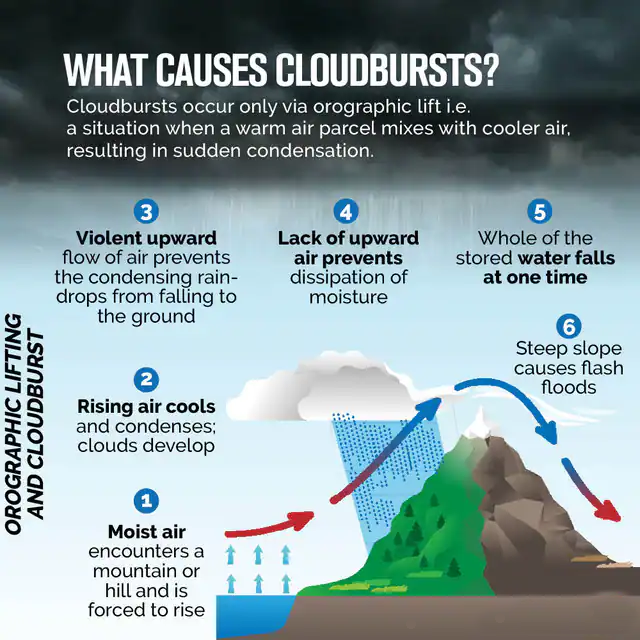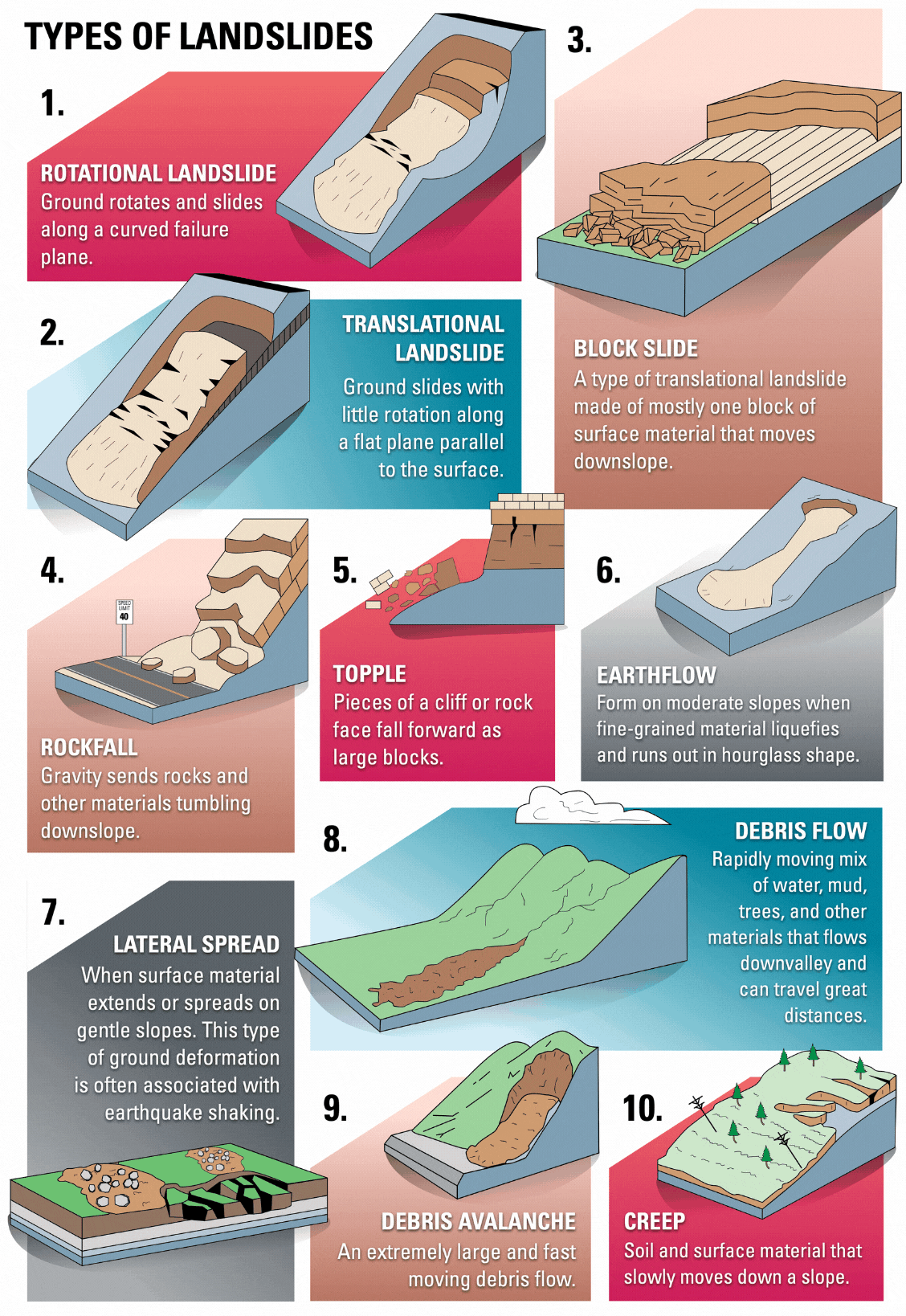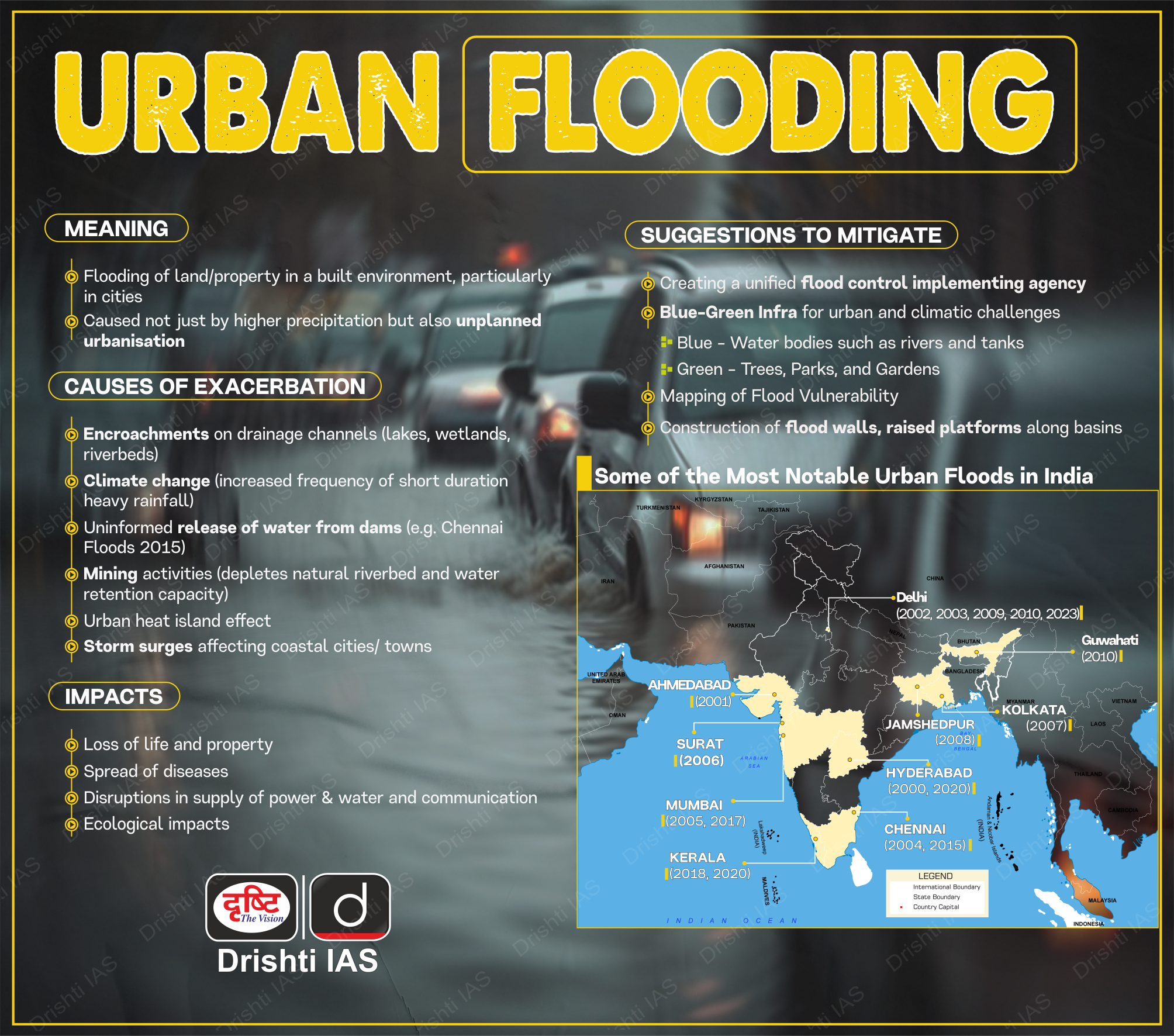Important Facts For Prelims
Cloudburst, Landslide, and Flash Flood
- 21 Apr 2025
- 6 min read
Why in News?
Torrential rain in Ramban tehsil of Jammu and Kashmir has caused casualties, significant infrastructure damage, and forced emergency relocations. Officials have cited cloudbursts, landslides and flash floods as the main triggers of the widespread destruction.
What is a Cloudburst?
- Definition: A cloudburst is a sudden, intense rainstorm that results in more than 10 cm of rain in less than an hour over a small area (approximately 10 km²).
- It can also be accompanied by hail and thunder. Cloudbursts are common in mountainous areas, especially in the Himalayas.
- Due to their localised nature, cloudbursts are hard to predict or detect but can unleash sudden, devastating rainfall, leading to flash floods and landslides.
- Causes:
- Orographic Lifting: It occurs when moist air is forced to rise over a mountain range. As the air ascends, it cools and condenses, resulting in heavy rainfall.
- Strong upward air currents can cause raindrops to grow larger before they fall. When these currents weaken, the accumulated raindrops fall suddenly, leading to intense rainfall.
- Monsoon Dynamics: In the Indian subcontinent, a cloudburst typically occurs when a monsoon cloud moves northwards from the Bay of Bengal or Arabian Sea, crosses the plains, and reaches the Himalayas, releasing rainfall of up to 75 millimeters per hour.
- Orographic Lifting: It occurs when moist air is forced to rise over a mountain range. As the air ascends, it cools and condenses, resulting in heavy rainfall.
- Examples: Cloudbursts in Himachal Pradesh (2024) and Uttarakhand (2021) caused fatal floods, landslides, and extensive damage to infrastructure.
What is a Landslide?
- Definition: A landslide is the downward movement of rock, soil, or debris on a slope due to gravity.
- It is a form of mass wasting, where earth materials move down a slope under the influence of gravity.
- Types:
- Causes: Natural factors like heavy rainfall, earthquakes, and water seepage weaken slopes, while human activities such as deforestation and construction increase risks. Geological factors, such as soil composition and terrain, also affect slope stability and can lead to landslides.
- Landslide Prone Areas: In India, 0.42 million sq. km (12.6% of land area) is prone to landslides, with the North East Himalaya, North West Himalaya, Western Ghats, Konkan hills, and Eastern Ghats being the most affected.
- Examples: In 2024, Wayanad (Kerala) faced significant landslides, while the 2013 Kedarnath (Uttarakhand) landslide caused over 5,700 deaths.
- The 2021 Chamoli landslide, triggered by heavy rain and a glacier burst, led to widespread flooding and fatalities.
What is a Flash Flood?
- Definition: Flash floods are sudden increases in water levels during or immediately after intense rainfall. They are highly localized and short-lived events, typically occurring within 6 hours of rainfall.
- Causes: Flash floods are primarily caused by intense rainfall that overwhelms the soil’s absorption capacity and drainage systems.
- Apart from heavy rain, flash floods can also result from rapid snowmelt due to sudden temperature rise, dam or levee breaches, ice or debris jams, and sudden glacial lake outbursts.
- Additionally, urbanisation with impervious surfaces like roads and buildings increase runoff, reducing water absorption and intensifying flood risks.
- Examples: Himachal 2023, Uttarakhand 2013, and Mumbai 2005 each caused by intense rain, leading to heavy loss of life and property.
UPSC Civil Services Examination, Previous Year Questions (PYQs)
Prelims:
Q. La Nina is suspected to have caused recent floods in Australia. How is La Nina different from El Nino? (2011)
- La Nina is characterised by an usually cold ocean temperature in the equatorial Indian Ocean whereas El Nino is characterised by unusually warm ocean temperature in the equatorial Pacific Ocean.
- El Nino has an adverse effect on the south-west monsoon of India but La Nina has no effect on the monsoon climate.
Which of the statements given above is/are correct?
(a) 1 only
(b) 2 only
(c) Both 1 and 2
(d) Neither 1 nor 2
Ans: (d)
Mains
Q. Differentiate the causes of landslides in the Himalayan region and Western Ghats. (2021)
Q. The Himalayas are highly prone to landslides.” Discuss the causes and suggest suitable measures of mitigation. (2016)







